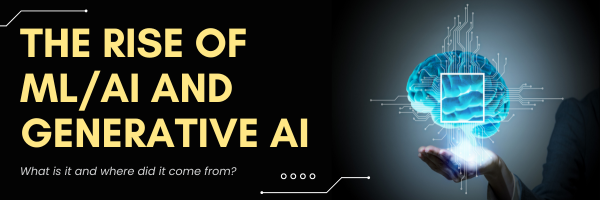Posted: April 24, 2024
Artificial intelligence (AI) has existed since the mid 1950s, however in the past few years, it is everywhere. AI has made it into every industry: automobiles, marketing, entertainment, you name it. Let's take a look at the rise of Generative AI and how machine learning (ML) has contributed to these seemingly rapid advancements.
What is Machine Learning?
Machine learning (ML) is a subset of AI that uses data and algorithms to allow computers to perform complex tasks without explicit instructions. The machine is literally learning how to detect a pattern in data sets, with or without the help of human users. According to IBM, machine learning “enable[s] AI to imitate the way that humans learn, gradually improving its accuracy.”
Every improvement made and each algorithm learned by the machine, will better inform future models - much like the learning process humans go through. An article by UC Berkeley explains:
The typical supervised machine learning algorithm consists of roughly three components:
- A decision process: A recipe of calculations or other steps that takes in the data and “guesses” what kind of pattern your algorithm is looking to find.
- An error function: A method of measuring how good the guess was by comparing it to known examples (when they are available). Did the decision process get it right? If not, how do you quantify “how bad” the miss was?
- An updating or optimization process: A method in which the algorithm looks at the miss and then updates how the decision process comes to the final decision, so next time the miss won’t be as great.
You’ll see from the steps listed above that ML functions similarly to the way humans learn and process new information. With this commonality, ML bridges the gap between technology and people, making AI function almost seamlessly.
What is Generative AI?
To put it simply, Generative AI generates new information based on existing data rather than predicting a pattern in the data. Generative AI is the type of AI that most people think of. It has multiple techniques:
Generative Adversarial Networks (GANs) - This deep learning technique uses two types of neural networks - a method of machine learning inspired by the human brain - to create the most realistic new data possible. One network uses an existing database and generates new data to appear authentic. The other network is tasked with analyzing the new data and predicting whether or not it belongs in the original dataset. This process is repeated until the first network generates data that the second cannot distinguish if it’s authentic or fake. AI images, for example, are able to look extremely realistic thanks to GANs.
Variational Autoencoders (VAEs) - Like GANs, VAEs have two types of neural networks, but they operate differently than GANs. One network (the encoder) is responsible for finding better ways to encode raw data, while the other (the decoder) is tasked with transforming these representations into new content, according to TechTarget.
These AI techniques have been around for over a decade and have become mainstream through popular internet channels. Many social media platforms use Generative AI in the form of “filters” where users can alter an image of themselves to look elderly, like a baby, or even putting themselves in a background setting of their choice.
Now, AI has gone beyond images. Popular platforms like Open AI’s ChatGPT have opened the door to a new world: natural language processing. Users can give the chatbot a simple prompt and it will generate human-like responses, poems, letters, songs, essays, etc. Generative AI’s use of natural language processing has dominated the customer-service scene. Most websites have a chat icon pop-up that allows you to chat with AI to find what you’re looking for.
AI/ML has existed for roughly 70 years, but it has exploded in popularity in the past decade. Now, it’s embedded into anything and everything technological - search engines, social media, streaming apps, business sites . . . the list goes on.
AI is rapidly advancing. It will be interesting to see what the future of Artificial Intelligence has in store for the world.

Elizabeth Casalnova,
(267) 396-7901
elizabeth.casalnova@trinityit.biz
